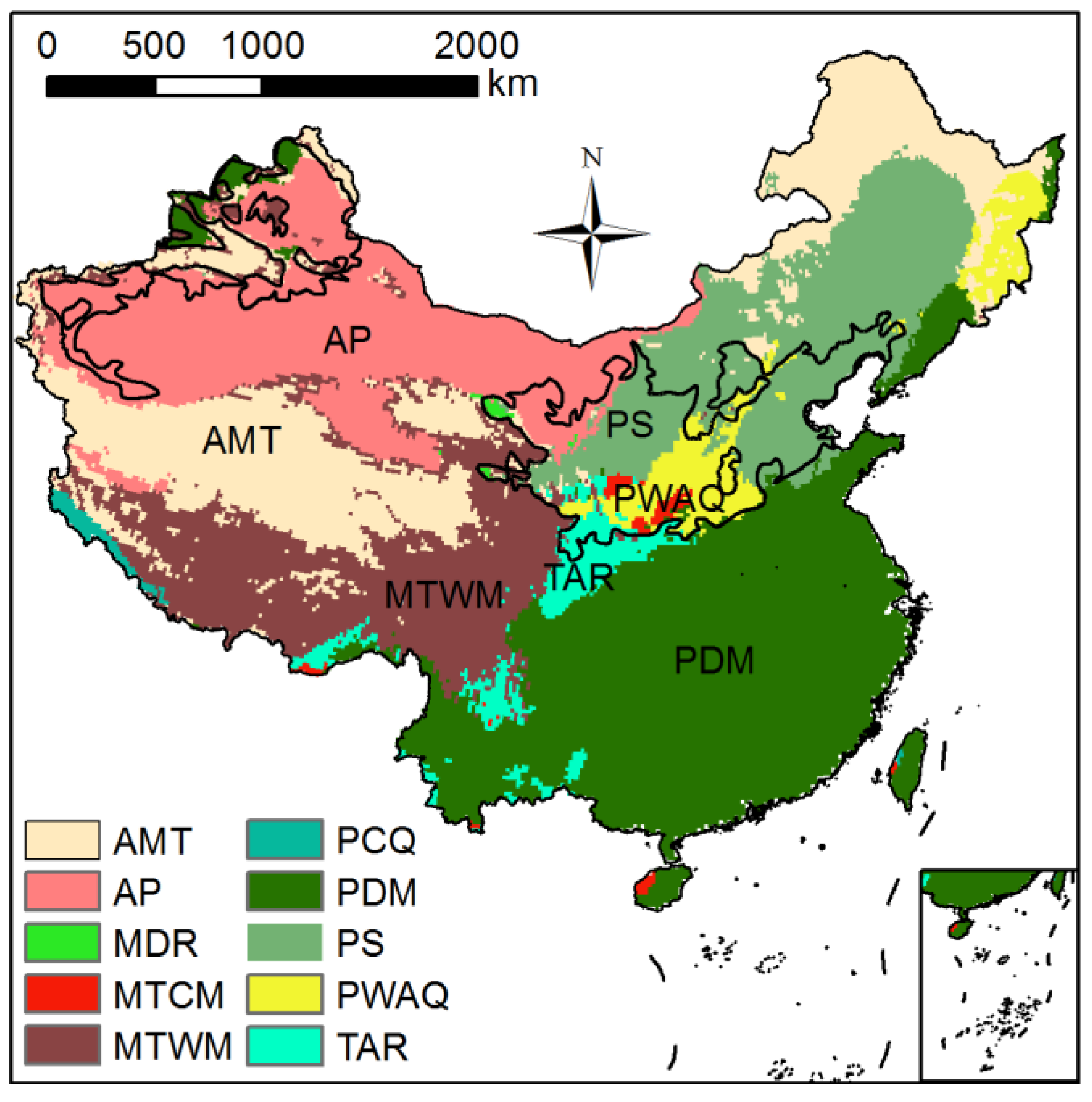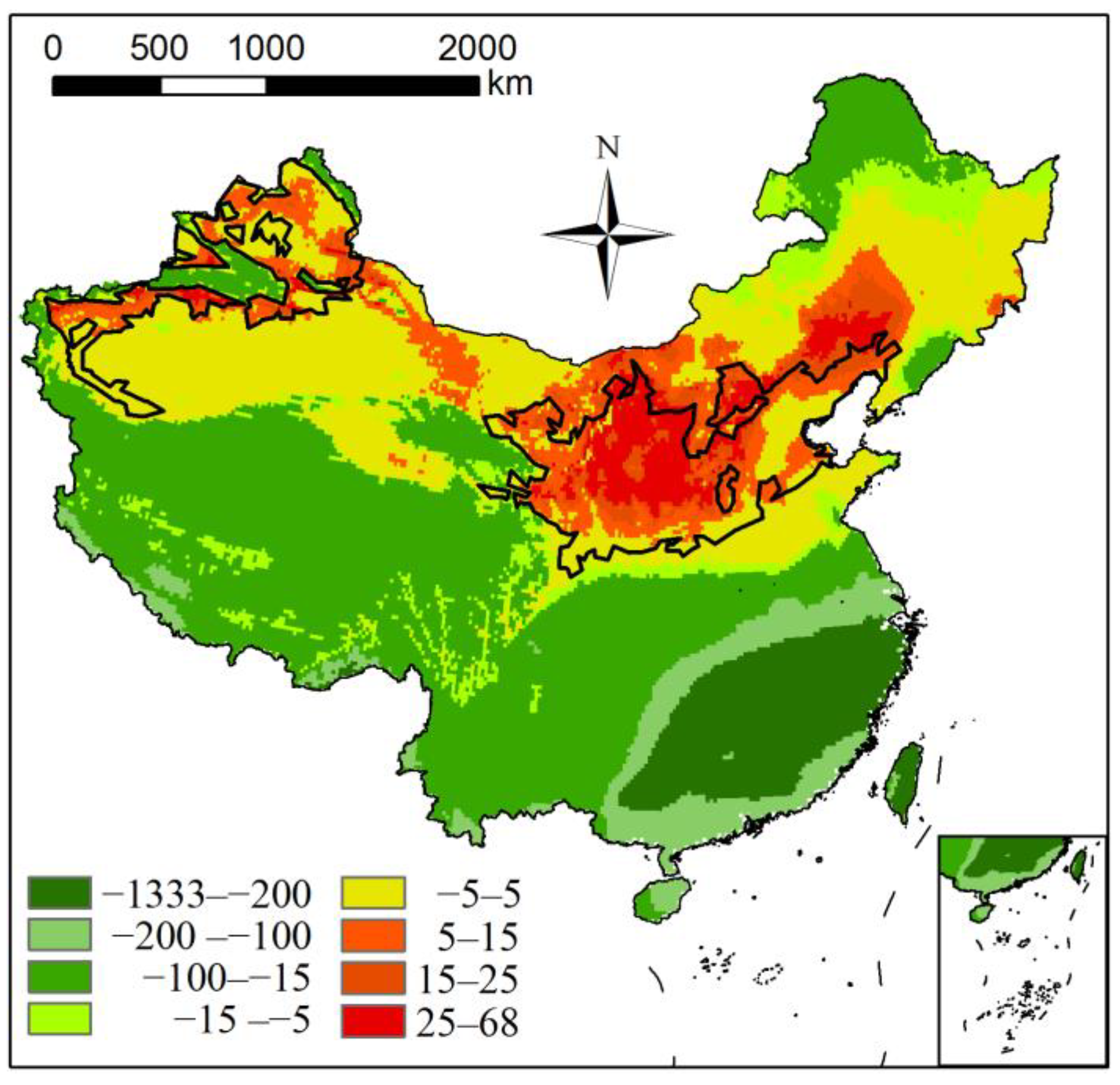Understanding the Limiting Climatic Factors on the Suitable Habitat of Chinese Alfalfa
Abstract
:1. Introduction
2. Materials and Methods
2.1. MaxEnt and Data Requirements
2.2. Limiting Climatic Mapping and Multivariate Environmental Similarity Surface
3. Results
3.1. Model Performance
3.2. Current and Potential Distribution of Chinese Alfalfa
3.3. Importance of Climatic Factors
3.4. Response Curves and Limiting Factors
4. Discussion
4.1. Understanding the Limiting Climatic Factors of Chinese Alfalfa
4.2. Application and Future Research
5. Conclusions
Author Contributions
Funding
Institutional Review Board Statement
Informed Consent Statement
Data Availability Statement
Acknowledgments
Conflicts of Interest
References
- Yin, F.; Deng, X.Z.; Jin, Q.; Yuan, Y.W.; Zhao, C.H. The impacts of climate change and human activities on grassland productivity in Qinghai Province, China. Front. Earth Sci. 2014, 8, 93–103. [Google Scholar] [CrossRef]
- State Environmental Protection Administration-SEPA. Report on China’s Ecological and Environmental Situation in 2002; State Environmental Protection Administration-SEPA: Beijing, China, 2002.
- Wang, X.G.; Han, J.G.; Dong, Y.P. Recent grassland policies in China—An overview. Outlook Agric. 2005, 34, 105–110. [Google Scholar] [CrossRef]
- Li, S.D.; Chen, Y.F. Progress and prospect of monitoring on benefits of the conversion of farmland to forests and grasses. For. Resour. Manag. 2021, 5, 1–9. [Google Scholar] [CrossRef]
- Yang, Z.Y.; Liu, Q.J.; Qin, L.H.; Liu, F.Z. Ecological benefit assessment of the Grain for green Project in Yan’an. J. Northwest For. Univ. 2022, 37, 259–266. [Google Scholar] [CrossRef]
- Wang, S.X. Five forage species suitable for landscape application in arid areas of northwest China. Gansu Agric. Sci. Tech. 2009, 11, 63–64. [Google Scholar]
- Wang, Z.X. Selection of cultivars for Planting Apocynum in the semi-arid region of western Liaoning province. Anim. Prod. 1994, 12, 21. [Google Scholar]
- Li, Y.S. Productivity dynamic of alfalfa and its effects on water eco-environment. Acta Pedol. Sin. 2002, 39, 404–411. [Google Scholar]
- Li, X.L.; Su, D.R.; Yuan, Q.H. Ridge-furrow planting of alfalfa (Medicago sativa L.) for improved rainwater harvest in rainfed semiarid areas in Northwest China. Soil Tillage Res. 2007, 93, 117–125. [Google Scholar] [CrossRef]
- Zheng, H.F. Alfalfa Science; China Agriculture Press: Beijing, China, 2009. [Google Scholar]
- Bouton, J.H. Breeding lucerne for persistence. Crop Pasture Sci. 2012, 63, 95–106. [Google Scholar] [CrossRef] [Green Version]
- Telekalo, N.; Melnyk, M. Agroecological substantiation of Medicago sativa cultivation technology. Agric. Res. 2020, 18, 2613–2626. [Google Scholar] [CrossRef]
- Thivierge, M.N.; Jego, G.; Belanger, G.; Bertrand, A.; Tremblay, G.F.; Rotz, C.A.; Qian, B.D. Predicted yield and nutritive value of an alfalfa-timothy mixture under climate change and elevated atmospheric carbon dioxide. Agron. J. 2016, 108, 585–603. [Google Scholar] [CrossRef] [Green Version]
- Medina-Garcia, G.; Echavarria-Chairez, F.G.; Ruiz-Corral, J.A.; Rodriguez-Moreno, V.M.; Sooria-Ruiz, J.; De La Mora-Orozco, C. Global warming effect on alfalfa production in Mexico. Rev. Mex. Cienc. Pecu. 2020, 11, 34–48. [Google Scholar] [CrossRef]
- Zhao, C.Y.; Feng, Z.D.; Chen, D.D. Soil water balance simulation of alfalfa (Medicago sativa L.) in the semiarid Chinese Loess Plateau. Agric. Water Manag. 2004, 69, 101–114. [Google Scholar] [CrossRef]
- Deng, F.; Li, X.B.; Wang, H.; Zhang, M.; Li, R.H.; Li, X. GIS-based assessment of land suitability for alfalfa cultivation: A case study in the dry continental steppes of northern China. Span. J. Agric. Res. 2014, 12, 364–375. [Google Scholar] [CrossRef] [Green Version]
- Xu, L.J.; Xu, D.W.; Pang, H.C.; Xin, X.P.; Jin, D.Y.; Tang, X.J.; Guo, M.Y. Chinese alfalfa habitat suitability regionalization. Pratacul. Sci. 2017, 34, 2347–2358. [Google Scholar] [CrossRef]
- Xu, K.; Wang, H.; Li, X.B.; Liu, H.H.; Chi, D.K.; Yu, F. Identifying areas suitable for cultivation of Medicago sativa L. In a typical steppe of Inner Mongolia. Environ. Earth Sci. 2016, 75, 341. [Google Scholar] [CrossRef]
- Guisan, A.; Thuiller, W. Predicting species distribution: Offering more than simple habitat models. Ecol. Lett. 2005, 8, 993–1009. [Google Scholar] [CrossRef]
- Nazeri, M.; Kumar, L.; Jusoff, K.; Bahaman, A.R. Modeling the potential distribution of sun bear in Krau wildlife reserve, Malaysia. Ecol. Inform. 2014, 20, 27–32. [Google Scholar] [CrossRef]
- Ponder, W.F.; Carter, G.A.; Flemons, P.; Chapman, R.R. Evaluation of museum collection data for use in biodiversity assessment. Conserv. Biol. 2001, 15, 648–657. [Google Scholar] [CrossRef]
- Tsoar, A.; Allouche, O.; Steinitz, O.; Rotem, D.; Kadmon, R. A comparative evaluation of presence-only methods for modelling species distribution. Divers. Distrib. 2007, 13, 397–405. [Google Scholar] [CrossRef]
- Qin, A.L.; Liu, B.; Guo, Q.S.; Bussmann, R.W.; Ma, F.Q.; Jian, Z.J.; Xu, G.X.; Pei, S.X. Maxent modeling for predicting impacts of climate change on the potential distribution of Thuja sutchuenensis Franch. an extremely endangered conifer from southwestern China. Glob. Ecol. Conserv. 2017, 10, 139–146. [Google Scholar] [CrossRef]
- Tang, X.G.; Yuan, Y.D.; Zhang, J.C. How climate change will alter the distribution of suitable Dendrobium habitats. Front. Ecol. Evol. 2020, 8, 536339. [Google Scholar] [CrossRef]
- Li, G.Q.; Du, S.; Wen, Z.M. Mapping the climatic suitable habitat of oriental arborvitae (Platycladus orientalis) for introduction and cultivation at a global scale. Sci. Rep. 2016, 6, 30009. [Google Scholar] [CrossRef] [PubMed] [Green Version]
- Elith, J.; Kearney, M.; Phillips, S. The art of modelling range-shifting species. Methods Ecol. Evol. 2010, 1, 330–342. [Google Scholar] [CrossRef]
- Phillips, S.J.; Dud´ık, M.; Schapire, R.E. A maximum entropy approach to species distribution modeling. In Proceedings of the Twenty-First International Conference on Machine Learning, Banff, AB, Canada, 14 July 2004; pp. 655–662. [Google Scholar]
- Phillips, S.J.; Anderson, R.P.; Schapire, R.E. Maximum entropy modeling of species geographic distributions. Ecol. Model. 2006, 190, 231–259. [Google Scholar] [CrossRef] [Green Version]
- Li, G.Q.; Du, S.; Guo, K. Evaluation of limiting climatic factors and simulation of a climatically suitable habitat for Chinese Sea Buckthorn. PLoS ONE 2015, 10, e0131659. [Google Scholar] [CrossRef]
- Wang, R.L.; Li, Q.; He, S.A.; Liu, Y.; Wang, M.T.; Jiang, G. Modeling and mapping the current and future distribution of Pseudomonas syringae pv. actinidiae under climate change in China. PLoS ONE 2018, 13, e0192153. [Google Scholar] [CrossRef] [Green Version]
- Zhang, X.Q.; Li, G.Q.; Du, S. Simulating the potential distribution of Elaeagnus angustifolia L. based on climatic constraints in China. Ecol. Eng. 2018, 113, 27–34. [Google Scholar] [CrossRef]
- Chen, I.C.; Hill, J.K.; Ohlemuller, R.; Roy, D.B.; Thomas, C.D. Rapid Range Shifts of Species Associated with High Levels of Climate Warming. Science 2011, 333, 1024–1026. [Google Scholar] [CrossRef]
- Krehenwinkel, H.; Tautz, D. Northern range expansion of European populations of the wasp spider Argiope bruennichi is associated with global warming correlated genetic admixture and population-specific temperature adaptations. Mol. Ecol. 2013, 22, 2232–2248. [Google Scholar] [CrossRef]
- Jin, J.; Wang, Q. Assessing ecological vulnerability in western China based on Time-Integrated NDVI data. J. Arid Land 2016, 8, 533–545. [Google Scholar] [CrossRef] [Green Version]
- Xu, B.; Yang, X.C.; Bai, K.Y.; Chen, Z.X.; Qin, Z.H.; Qiu, J.J. Alfalfa climatic subdivisions in China. Acta Agrestia Sin. 2007, 15, 316–321. [Google Scholar]
- Liu, Y.H. Study on the Relations between Growth Development and Yield Formation of Alfalfa and Climate Conditions; Northwest A & F University: Yangling, China, 2006. [Google Scholar]
- Guilbault, K.R.; Brown, C.S.; Friedman, J.M.; Shafroth, P.B. The influence of chilling requirement on the southern distribution limit of exotic Russian olive (Elaeagnus angustifolia) in western North America. Biol. Invasions 2012, 14, 1711–1724. [Google Scholar] [CrossRef] [Green Version]
- Fang, Q.E. Study on the Rules of Alfalfa Crown Bud Developing into Shoot and Its Winter Hardiness in the State of Dormancy; Gansu Agricultural University: Lanzhou, China, 2016. [Google Scholar]
- Niles, M.T.; Lubell, M.; Brown, M. How limiting factors drive agricultural adaptation to climate change. Agric Ecosyst. Environ. 2015, 200, 178–185. [Google Scholar] [CrossRef] [Green Version]
- Chu, S.L. The Study on Climatic Regionalization of Alfalfa Based on GIS Technology in China; Lanzhou University: Lanzhou, China, 2008. [Google Scholar]
- Peterson, A.T.; Soberón, J.; Pearson, R.G.; Anderson, R.P.; Martínez-Meyer, E.; Nakamura, M.; Araújo, M.B. Ecological Niches and Geographic Distributions (MPB-49). In Monographs in Population Biology; Princeton University Press: Princeton, NJ, USA, 2011; p. 49. [Google Scholar] [CrossRef]
- Pincebourde, S.; Murdock, C.C.; Vickers, M.; Sears, M.W. Fine-Scale Microclimatic Variation Can Shape the Responses of Organisms to Global Change in Both Natural and Urban Environments. Integr. Comp. Biol. 2016, 56, 45–61. [Google Scholar] [CrossRef] [PubMed] [Green Version]
- Li, G.Q.; Rogers, P.C.; Huang, J.H. Black locust (Robinia pseudoacacia L.) range shifts in China_ Application of a global model in climate change futures. Clim. Change Ecol. 2021, 2, 100036. [Google Scholar] [CrossRef]




| Climatic Variables | Abbreviation | Unit |
|---|---|---|
| Annual mean temperature | AMT | °C |
| Mean diurnal range | MDR | °C |
| Isothermality | IS | °C |
| SD of temperature seasonality | TS | °C |
| Max temperature of warmest month | MTWM | °C |
| Min temperature of coldest month | MTCM | °C |
| Temperature annual range | TAR | °C |
| Mean temperature of wettest quarter | MTWQ | °C |
| Mean temperature of driest quarter | MTDQ | °C |
| Mean temperature of warmest quarter | MTWAQ | °C |
| Mean temperature of coldest quarter | MTCQ | °C |
| Annual precipitation | AP | mm |
| Precipitation of wettest month | PWM | mm |
| Precipitation of driest month | PDM | mm |
| Precipitation seasonality | PS | % |
| Precipitation of wettest quarter | PWQ | mm |
| Precipitation of driest quarter | PDQ | mm |
| Precipitation of warmest quarter | PWAQ | mm |
| Precipitation of coldest quarter | PCQ | mm |
| Climatic Factor | Relative Importance (%) | Climatic Thresholds | |||
|---|---|---|---|---|---|
| Highly Suitable (0.7–1.0) | Moderately Suitable (0.5–0.7) | Lowly Suitable (0.3–0.5) | Unsuitable (0.0–0.3) | ||
| PDM | 16 | 0.0–14.0 | 0.0–14.0 | 0.0–34.0 | 0.0–200.0 |
| PS | 12.9 | 23.8–108.2 | 28.7–151.0 | 32–150.2 | 21.9–146.4 |
| AMT | 11 | 3.9–15.5 | 1.8–15.3 | −0.2–14.7 | −16.1–25.5 |
| AP | 10.8 | 14.0–664.0 | 15.0–675.0 | 15–778.0 | 12.0–3846.0 |
| PDQ | 9.7 | 1.0–47.0 | 1.0–47.0 | 1.0–112.0 | 0.0–726.0 |
| PCQ | 9.2 | 2.0–51.0 | 2.0–49.0 | 1.0–54.0 | 0.0–761.0 |
| MTWM | 6.8 | 21.4–42.0 | 20.5–42.0 | 19.2–42.4 | 1.5–39.1 |
| TAR | 4 | 33.9–55.1 | 30.6–56.0 | 28.2–57.1 | 13.3–62.5 |
| TS | 3.9 | 839.7–1616.6 | 765.7–1672.1 | 629.4.0–1658.9 | 283.4–1752.0 |
| MTCM | 3.3 | −21.8–4.5 | −26.4–4.3 | −27.2–3.4 | −37.3–17.4 |
| MDR | 2.9 | 9.7–14.7 | 9.0–16.2 | 7.9–17.5 | 5.0–18.4 |
| PWAQ | 2.2 | 8.0–335.0 | 9.0–472.0 | 10.0–471 | 10.0–2339.0 |
| MTDQ | 2.2 | −14.0–12.2 | −14.5–12.5 | −16.1–12.5 | −27.3–22.3 |
| IS | 1.6 | 18.8–36.4 | 19.0–37.1 | 18.5–38.2 | 18.5–53.4 |
| MTCQ | 1.4 | −14.0–1.6 | −17.6–1.7 | −19.0–2.5 | −27.6–21.4 |
| MTWQ | 0.8 | 14.1–32.6 | 13.8–32.4 | 13.0–31.5 | −15.4–29.8 |
| PWM | 0.6 | 3.0–116 | 4.0–228.0 | 4.0–227.0 | 4.0–924.0 |
| PWQ | 0.3 | 8.0–345.0 | 9.0–472.0 | 10.0–471.0 | 10.0–2239.0 |
| MTWAQ | 0.2 | 14.4–32.6 | 13.8–32.4 | 11.7–31.5 | −5.1–29.9 |
Publisher’s Note: MDPI stays neutral with regard to jurisdictional claims in published maps and institutional affiliations. |
© 2022 by the authors. Licensee MDPI, Basel, Switzerland. This article is an open access article distributed under the terms and conditions of the Creative Commons Attribution (CC BY) license (https://creativecommons.org/licenses/by/4.0/).
Share and Cite
Zhang, Y.; Liu, G.; Lu, Q.; Xiong, D.; Li, G.; Du, S. Understanding the Limiting Climatic Factors on the Suitable Habitat of Chinese Alfalfa. Forests 2022, 13, 482. https://doi.org/10.3390/f13030482
Zhang Y, Liu G, Lu Q, Xiong D, Li G, Du S. Understanding the Limiting Climatic Factors on the Suitable Habitat of Chinese Alfalfa. Forests. 2022; 13(3):482. https://doi.org/10.3390/f13030482
Chicago/Turabian StyleZhang, Yanru, Guan Liu, Qi Lu, Dongyang Xiong, Guoqing Li, and Sheng Du. 2022. "Understanding the Limiting Climatic Factors on the Suitable Habitat of Chinese Alfalfa" Forests 13, no. 3: 482. https://doi.org/10.3390/f13030482






